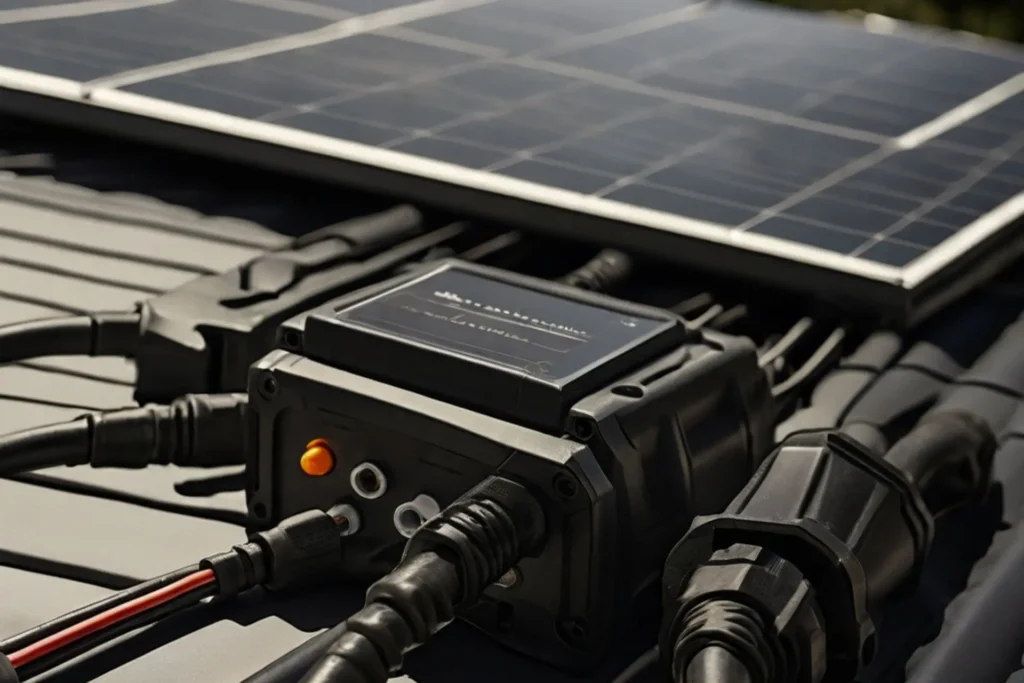Solar cells are becoming a more popular way for homes and companies to get clean, green energy. But have you ever thought about What cable is used for solar panels to inverter?
Solar wires do a lot of the work that doesn’t get noticed. These special wires are needed to safely and efficiently send the valuable direct current (DC) power that your solar panels make. In the blog, we will get you covered with all your problems.
Types of Solar Panel Cables
Not every wire is the same, and solar apps need certain features to make sure they work well and last a long time. There are three main types of solar wires that you’ll come across:
PV Wire:
PV Wire, also called solar cable, is the most common way to connect solar panels. PV wire is made to resist the hard conditions of the outdoors. It can with stand high temperatures as well as UV rays and bad weather which makes it perfect for connecting individual solar panels and strings.
From what I’ve seen, cross-linked polyethylene (XLPE) is usually used to protect PV wire to make it last longer.
USE-2 Wire:
Another popular choice for solar systems is USE-2 wire. It has a lot of the same qualities as PV wire, like being resistant to UV light and waterproof.
But because it can be buried directly, USE-2 wire is often used for tasks that need to be done underground. This gets rid of the need for tubing which could make assembly easier.
THHN Wire:
THHN wire is a more general-purpose line that is often used for wiring in homes. It might work for indoor solar tasks like connecting the generator to the main power panel, but it might not be the best choice for outdoor use since it doesn’t fight UV light as well as PV wire and USE-2 wire.
If you are looking to install solar panel at a reasonable price, then you won’t find a better offer than this!
Click and Get A Quote!
Key Features of a Solar Cable
Now, look at the main things that set them apart and help you make your choice of the best cable from solar panel to inverter in usa such as:
Material for the wire:
Copper is the most popular material for the wire in solar lines. Copper is a great conductor, which means that very little energy is lost during transfer. Aluminum is a less expensive option, but it is less conductive, so bigger cables are needed to carry the same amount of power.
Insulation:
The material used for insulation is very important for keeping the wire safe from the weather. XLPE is often used because it is long-lasting, doesn’t fade in UV light, and can handle high temperatures. Polyvinyl chloride (PVC) and ethylene propylene rubber (EPR) are two other choices.
Rating for Voltage:
Solar wires have different grades for voltage, usually between 600V and 2000V. The right voltage grade is based on the design voltage of your equipment. By picking the right voltage, you can be sure that the line can handle the highest power that your panels can produce without breaking.
Wire Gauge:
The wire gauge tells you how wide the connection is. Wires with a wider size can carry more power with less voltage drop. A skilled solar technician will figure out the best wire gauge for your system by looking at its size, how much power it needs, and the length of the line.
What Cable is Used for Solar Panels to Inverter?
This tutorial explains what cable is used for solar panels to inverter in four simple stages.
Size Up Your Solar Array
Consider your solar panels’ overall wattage first. Think of watts as solar system engine power. Higher wattage requires larger cables.
Calculate the current crew
Solar panels are rated in amps like vehicle batteries. We must determine your solar array’s maximum amps (current). If you have parallel panels supplying voltage, add their amps. When panels are linked in series (like train carriages contributing electricity), the total amps remain the same.
Watts
Divide your solar array’s wattage by 12. Round this to 10. This will define the charge controller’s size (your solar system’s electrical traffic policeman).
Consider Distance
The distance between your solar panels and inverter matters. To reduce power losses and traffic bottlenecks, longer cable lines need thicker wires, as a highway needs wider lanes.
Based on the charge controller distance and amperage rating, use the table below to choose the right solar cable size.
We have some offers for solar installation. This is very helpful Just Contact Us Get A Quote!
Conclusion
It is very important to choose the what size of your solar panel. This guide tells you how to pick the right size based on the power and distance of your system.
To make sure your system works well and is safe, remember to talk to a solar contractor.
If you want to know more about the solar process then read the next article and take multiple wonderful ideas about DIY solar installation.


